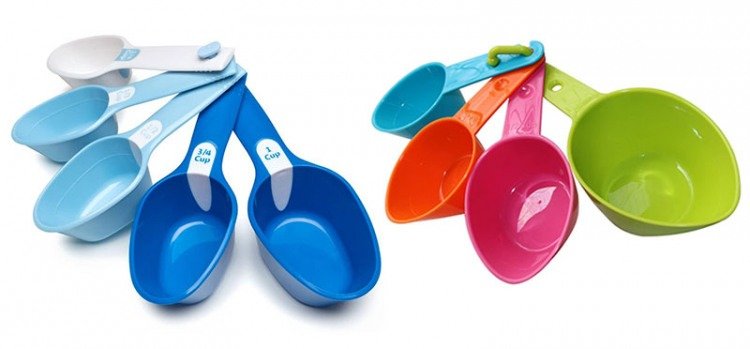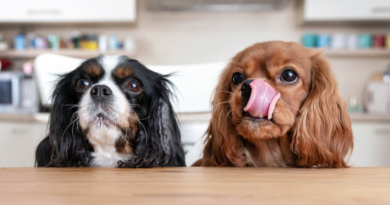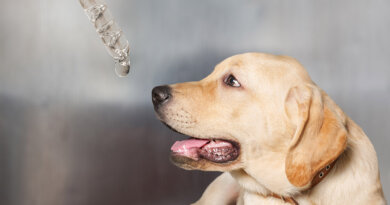When Is a Cup Not a Cup?
When is a cup not a cup? No, this isn’t a Buddhist koan. But it was a question that might come up when you are trying to feed your dog correct portions of their pet food. Many vets believe that understanding how much to feed your dog is one of the biggest factors in the worldwide epidemic of pet obesity. It really matters to your dog’s overall health to get this correctly. So, knowing not only the correct amount of food to give to your dog, but how to actually measure it out, is important.
Confusing Labeling from the Pet Food Industry
AAFCO (Association of American Feed Control Officials) labeling instructions don’t make it easy for consumers. On pet food packaging you will see vague feeding guidelines, such as, “for a dog 40 to 60 pounds, feed 1 to 2 cups” daily. It’s imprecise not only because of the wide range of 40 to 60 pounds for the dog’s weight, but also because of the use of the generalized word “cup.” If you use one of the standard measuring cups found in your kitchen—like a popular Pyrex one—and fill it with dog food, you might wind up under- or (more alarmingly, and more likely) overfeeding your dog. It’s a really essential point because most measuring cups are intended to measure fluids, not dry weights.
What many of us think of as a measuring standard “one cup equals eight ounces” doesn’t translate the same to dry matter (like kibble and most ingredients such as flour, sugar etc.) as it does to liquids. A much more accurate way to express feeding recommendations would be to provide the instructions in actual ounces or grams, such as “feed a 20 lbs. dog 6 oz. of food daily,” and ditch the word “cup.”
GET THE BARK IN YOUR INBOX!
Sign up for our newsletter and stay in the know.
What you also need to know is how many calories there is in the food you feed your dog, it’s the calorie density that must appear on pet-food packaging in the metric form kcal/kg, or kilocalories per kilogram, as per AAFCO. So, using metrics like that further complicates things when the feeding amounts themselves are given in cups. Plus for those of us who do not use metric measurements, we need to convert the kcal/kg to kcal/oz. and feed accordingly. (See end of article for the formula.)
Consider this possible scenario: The Daily Energy Requirement (DER) for a 20-pound, neutered, adult dog is 586 kcal, and perhaps you calculated that the food you’re giving her has 97.9 kcals per ounce. So, your dog should be fed 5.9 ounces of that food, not 8 ounces, as could be the case if you’re using a standard measuring cup and filling it to the top. Even slight variations in how many calories a dog consumes daily can have a large effect over time. (To calculate your dog’s DER, see thebark.com/der.)
As pet food consumer advocate Susan Thixton notes on truthaboutpetfood.com, AAFCO is pondering the inclusion of an explanation of calorie amounts per cup. Personally, I don’t think that will solve the problem, because we would still be stuck with the “When is a cup not a cup?” riddle.
Wide Range of Dog-Food Weights in a “Cup”
A few of the brands I checked with, including The Honest Kitchen and Orijen (made by Champion Petfoods) actually equate their cup as being around 4.0 oz., for the former and 4.2 oz. for the latter, which allows you to determine how many calories you’re actually feeding your dog. I was told by a representative from The Honest Kitchen that this was a “standard” dry measuring cup, although they do not provide that definition on their site or packaging and, besides that, there really isn’t anything like a standard “cup.” And to complicate matters even further, small print in the textbook, Small Animal Clinical Nutrition (4th Edition), says that “an 8-oz. measuring cup can hold 3 to 3.5 oz. by weight of most dry pet foods or 3.5 to 5 oz. of most semi-moist pet food.” That only goes to show that there is little consistency in the industry, and a lot more confusion for the consumers.
ZiwiPeak is among the few companies to provide a handy scoop tailored to their food, which is very helpful as long as you remember to only use that scoop. Their air-dried food is a very dense 5,600 kcal/kg, or a whopping 158 kcal/oz. Their scoop measures two ounces (or 316 kcals), which they note on the scoop itself and on the bag. But, like many pet-food bags, the calorie content statement appears beneath the nutritional Guaranteed Analysis panel on one side of the package and the feeding guidelines are listed on the other side. You may have to search to find this valuable information. (Oddly, you can’t count on finding it on every manufacturer’s website, which makes it doubly worthwhile to consult the packaging and to call them to verify that.)
Better Option: Using a Scoop Made for Pet Food
Curious, I set up an experiment with a variety of common kitchen ingredients and an array of kitchen measuring cups, plus two scoop utensils specifically made for pet food. The cups included three popular slant-sided glass Pyrex cups of various sizes and a variety of straight-sided cups (supposedly meant for dry ingredient measuring), I portioned out sugar, flours and several types of grain, then weighed their contents on a digital scale. Much to my surprise, I found that every one of the measuring devices provided different weights for each ingredient. Even though the scoop-type cups are meant to measure dry weight, it is difficult to get it exact, because ingredients need to be leveled off with a flat edge or packed down/added to, which can be a lot more complicated when you’re working with dense or large grain-sized foods. Many websites devoted to baking (where precision matters) often note that weights can even vary with how you actually scoop out an ingredient, such as flour, from a storage container, and therefore always recommend the use of digital scales over standard measuring utensils. (If you really want to be granular, one teaspoon of baking soda doesn’t weigh the same as one teaspoon of baking powder or salt!)

Very Best Option: Weighing Dog Food Right on a Digital Scale
Here’s the takeaway. Measuring volume can be tricky, especially with dry pet food, with all its myriad shapes and sizes like in kibble; or in grain-like dehydrated form; or flake-like freeze- or air-dried varieties. My recommendation is to be the most precise you need to use a small kitchen digital scale to portion out servings—scales are inexpensive and very handy to have in a kitchen. If in doubt about how much to feed your dog, check with your vet to confirm your dog’s weight, body condition scoring and then her target calorie needs and then the amounts of the dog food you feed her in ounces or grams. And remember, knowing the spot-on correct amount of food your dog needs can help you keep her trim, fit and healthy.
To note: When giving your dog treats, keep her overall daily calorie needs in mind. Remember that treats should not exceed 10% of your dog’s daily needs, so check the packaging for the number of calories per treat. If your dog requires a total of 600 kcal per day that means that all the treats given in a day should not exceed 60 kcals, with most treats that might be a challenge, so you need to break the treat up into smaller bits.
Important Weight Conversions: To convert kcals/kg into kcals/oz., divide the number of kcals by 35.27 (the number of ounces in a kilogram). For example, the label indicates that a food has 3,456 kcals/kg; divided by 35.27, that comes to 97.9 kcal/oz. And to convert grams to ounces, divide the grams by 28.35. Or even easier, use Google to do the conversion.




